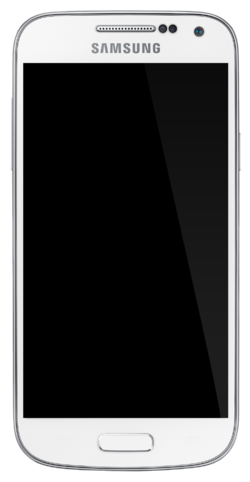 | |
 Galaxy S4 mini in White frost | |
| Manufacturer | Samsung Electronics |
|---|---|
| Type | Touchscreen smartphone |
| Series | Galaxy S |
| First released | July 2013 |
| Predecessor | Samsung Galaxy S III Mini |
| Successor | Samsung Galaxy S5 Mini |
| Related | Samsung Galaxy S4 Samsung Galaxy S4 Active Samsung Galaxy S4 Zoom Samsung Galaxy Note 3 |
| Compatible networks | 2G GSM/GPRS/EDGE – 850, 900, 1800, 1900 MHz [1] 3G UMTS/HSPA+ – 850, 900, 1900, 2100 MHz [1] Contents |
| Form factor | Slate |
| Dimensions | 124.6 mm (4.91 in) H 61.3 mm (2.41 in) W 8.9 mm (0.35 in) D |
| Weight | 107 g (3.8 oz) |
| Operating system | Original: Android 4.2.2 with Linux 3.4.x (GT-I9195), Android 4.4.4 with Linux 3.10.x (GT-I9195I) Current: Android 4.4.2 (GT-I9195), [2] Android 4.4.4 (GT-I9195I) Unofficial: LineageOS 19.1 (based on Android 12) |
| System-on-chip | Qualcomm Snapdragon 400 (8230AB/8930AB) / Snapdragon 410 (8916) |
| CPU | 1.7 GHz dual-core Krait 300 1.2 GHz Quad-core Cortex-A53 (S4 Mini Plus) |
| GPU | Adreno 305 |
| Memory | 1.5 GB |
| Storage | 8 GB (5 GB user available) |
| Removable storage | Up to 64 GB microSDXC |
| Battery | 1900 mAh (7.22 Wh 3.8 V) Li-ion |
| Rear camera | List
|
| Front camera | 1.9 MP, HD video (720p) at 60 fps |
| Display | 4.27 in (108 mm) RGB Super AMOLED [3] 960x540 px, qHD (258 PPI) Corning Gorilla Glass [3] [4] |
| Connectivity | 3.5 mm TRRS; Wi-Fi (802.11a/b/g/n 2.4 & 5 GHz); Wi-Fi Direct; Bluetooth 4.0; micro USB 2.0; NFC (GT-I9195); DLNA; UMA |
| Data inputs | Multi-touch capacitive touchscreen, headset controls, Proximity sensor, Ambient light sensor, 3-axis Gyroscope, Magnetometer, Accelerometer, IR Blaster, aGPS, GLONASS |
| Website | Galaxy S4 Mini website (archived) |
The Samsung Galaxy S4 Mini (stylized as Samsung GALAXY S4 mini) is an Android smartphone developed by the Korean manufacturer Samsung Electronics. Announced on May 31, 2013 and released in July 2013, the S4 Mini is a mid-range model of its flagship Galaxy S4 smartphone and a successor to the Galaxy S III Mini. It has a similar hardware design and software features to its high-end counterpart. [5] [6]
